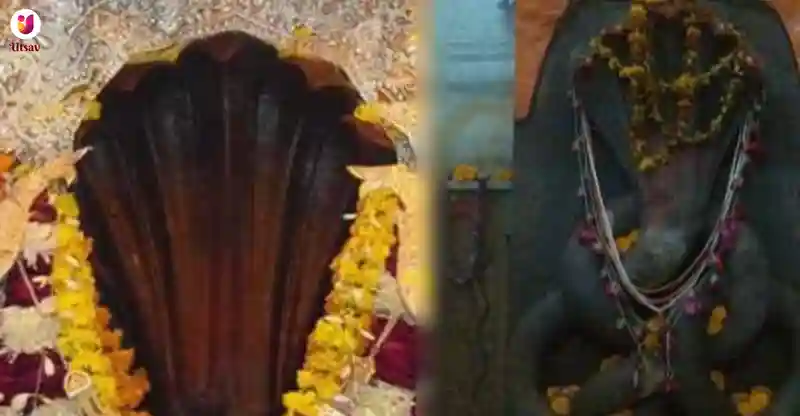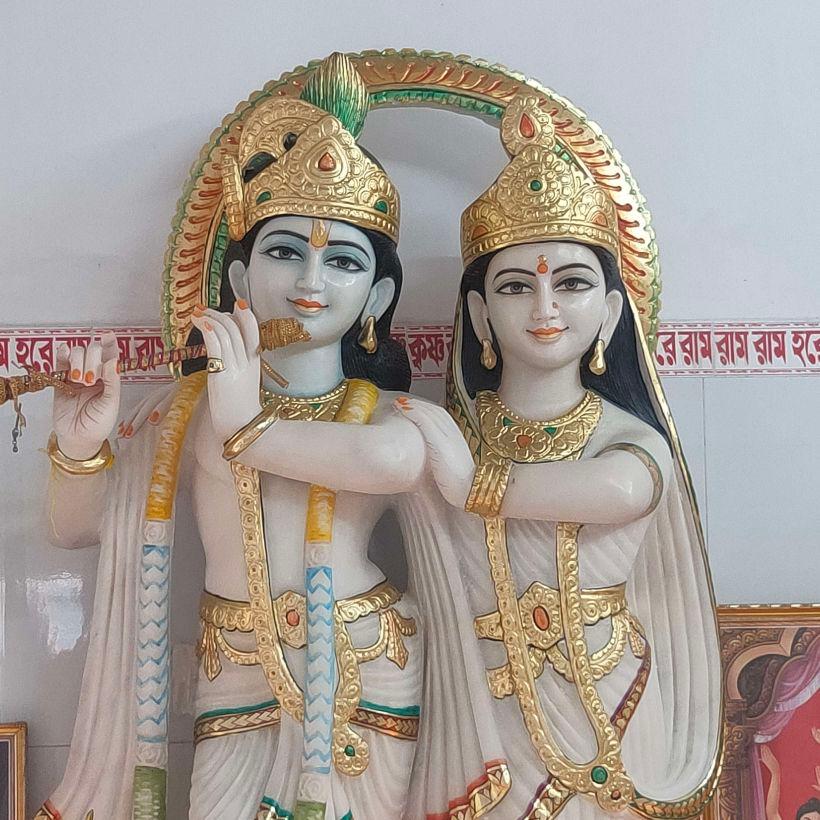Nag Vasuki Temple, Prayagraj
Situated on the sacred banks of the Ganges in Prayagraj, the Nag Vasuki Temple is a symbol of faith and perseverance, attracting devotees and visitors to its sacred land. Dedicated to Lord Vasuki, the revered king of serpents, the temple is steeped in rich scriptures and history, serving as a spiritual sanctuary for those seeking solace and blessings. The origin of the temple is linked to the churning of the ocean of milk, an important event in Hindu cosmology that symbolises the eternal struggle between good and evil. Beyond its spiritual significance, the Nag Vasuki Temple is a testament to the enduring power of devotion, having withstood the test of time and adversity, including attempts at destruction during the Mughal era. Today, it not only offers a place for prayer and contemplation, but also stands as a vibrant hub for cultural and religious festivities, especially on the auspicious occasion of Nag Panchami. As you step into this sacred place, you are invited to experience ancient traditions and a profound connection with divinity, making your visit a truly transformative journey.
Table of Contents
1. History of Nag Vasuki Temple
2. Architecture of Nag Vasuki Temple
3. Important site for snake worship
4. Rituals performed during Nag Panchami at Nag Vasuki Temple
5. When to visit Nag Vasuki Temple?
6. How to reach Nag Vasuki Temple?

History of Nag Vasuki Temple
The history of Nag Vasuki Temple in Prayag Raj is rich and fascinating. The Padma Purana narrates the tale of Lord Nagvasuki residing at this place. After the Samudra Manthan, Lord Nagvasuki was tired and injured and was looking for a place to rest. On the advice of Lord Vishnu, he bathed in the cool waters of the Saraswati River in Prayagraj and found peace. When he was about to leave, the sages and gods requested him to stop. He agreed with certain conditions, including that devotees would have to take a dip in the Triveni Sangam during the month of Sawan and worship them on Nag Panchami. The temple's resilience is particularly notable during the Mughal period, when many Hindu temples faced destruction; legend has it that a fierce form of Nagvasuki appeared to protect the temple from Aurangzeb's attempts to demolish it. Today, the Nag Vasuki temple stands testimony to the everlasting spirit of devotion, its historical significance, and the eternal allure of the serpent deity enshrined in it.
Architecture of Nag Vasuki Temple
1. The temple is built in the classic Hindu architectural style, with a large central hall and a sanctum at the back.
2. The sanctum houses a black stone idol of Lord Vasuki with five hoods and four coils, symbolising protection and spiritual awakening.
3. The temple complex includes smaller shrines dedicated to other deities such as Lord Shiva, Lord Ganesha, Goddess Parvati, and Bhishma.
4. The temple comprises stones dating back to the 10th century, which reflect its historical significance and age.
5. Renovated in the 18th century by Maratha king Shridhar Bhonsle, the temple reflects a blend of ancient and recent architectural styles.
6. The temple has elaborate carvings and sculptures depicting various aspects of Hindu scriptures, especially the Samudra manthan.
7. The temple is decorated with bright colours, mainly yellow and orange, which add to its visual appeal.
8. Located on the banks of the river Ganges, the temple offers amazing views, which further enhance its spiritual atmosphere.
Important site for snake worship
The Nag Vasuki temple is considered an important site for snake worship due to several key factors:
1. Diety: The temple is dedicated to Lord Vasuki, the king of serpents, who is believed to have rested here after the Samudra manthan, an important event in Hindu mythology where gods and demons churned the ocean of milk to obtain the nectar of immortality. This connection to a major mythological event enhances its significance as a site for snake worship.
2. Relief from Kaal Sarpa Dosha: It is one of the few temples in India where devotees seek relief from Kaal Sarpa Dosha, an astrological condition believed to cause various life challenges. The rituals performed here are believed to reduce the negative effects of this dosha, making the temple an important place for those seeking spiritual and astrological healing.
3. Nag Panchami Festival: The temple is a focal point during the annual Nag Panchami festival, dedicated to snake worship. Thousands of devotees gather to perform rituals, offer prayers, and participate in the grand celebrations, reinforcing the temple's role as a centre for snake worship.
4. Cultural Heritage: The worship of snakes has deep roots in Hindu culture, with references found in ancient texts and practices. The Nag Vasuki Temple embodies this tradition, attracting visitors interested in the historical and cultural aspects of snake worship in Hinduism.
5.Sacred Place: Located on the banks of the River Ganges, the temple is part of the Triveni Sangam, where three sacred rivers meet. This adds to its spiritual significance, as taking a holy dip in these waters purifies the soul, further promoting the snake worship at the temple.
Rituals Performed During Nag Panchami at Nag Vasuki Temple
During the annual Nag Panchami festival, which is celebrated on the Hindu lunar calendar, snakes are worshipped by the devotees.
On Nag Panchami, which usually falls in July or August according to the Hindu calendar, devotees perform various rituals and prayers at the Nagvasuki Temple in Prayagraj:
Praying: Thousands of devotees visit the temple to pray and seek blessings from Lord Vasuki, the king of snakes.
Offering milk and flowers: Devotees offer milk, flowers, fruits and coins to the serpent god. Some even pour milk directly from a silver bowl into the idol's mouth.
Holy dip in the Ganga: Many devotees take a holy dip in the nearby Ganga river before visiting the temple. Some also take a dip in the Triveni Sangam, which is the confluence of the Ganga, Yamuna and Saraswati rivers.
Fasting: Married women often observe fasts and pray for the well-being of their family.
Idol making: Some devotees make snake idols at home from clay, offer flowers and milk to them and place them near the burrows or burrows of snakes.
Elaborate rituals: Temple priests perform elaborate rituals and aarti ceremonies during Nag Panchami.
Decorations: Houses are decorated with colourful rangolis and people celebrate the occasion by wearing bright clothes.
When to visit Nag Vasuki Temple?
One must visit Nag Vasuki Temple during the Nag Panchami festival. This festival dedicated to snake worship attracts huge crowds and festivities at the temple. The weather in Prayagraj is pleasant from September to March, when the weather is pleasant. The winter season, especially from September to February, is considered the best season to visit the temple. Avoid visiting during the summer months of April to June, when the temperature can reach 39 degrees Celsius during the day. The temple is open for darshan every day from 10:30 am to 4:30 pm. Devotees often stand in long queues for hours during festivals to get a darshan and pray to Vasuki deity. Dress modestly as a sign of respect while visiting the temple.
How to reach Nagvasuki Temple?
By Air: Fly to Bamrauli Airport located on the outskirts of Prayagraj. From the airport, you can take a taxi or auto-rickshaw to the temple.
By Train: The nearest major railway station is Prayagraj Junction, which is about 7.4 km from the temple. You can take an auto-rickshaw, taxi or local bus from the station to reach the temple.
By Road: Prayagraj is well connected by national and state highways. You can travel by inter-state buses from nearby cities or by car. Local transport options like auto-rickshaws and taxis are available to reach the temple from various places in the city.
















